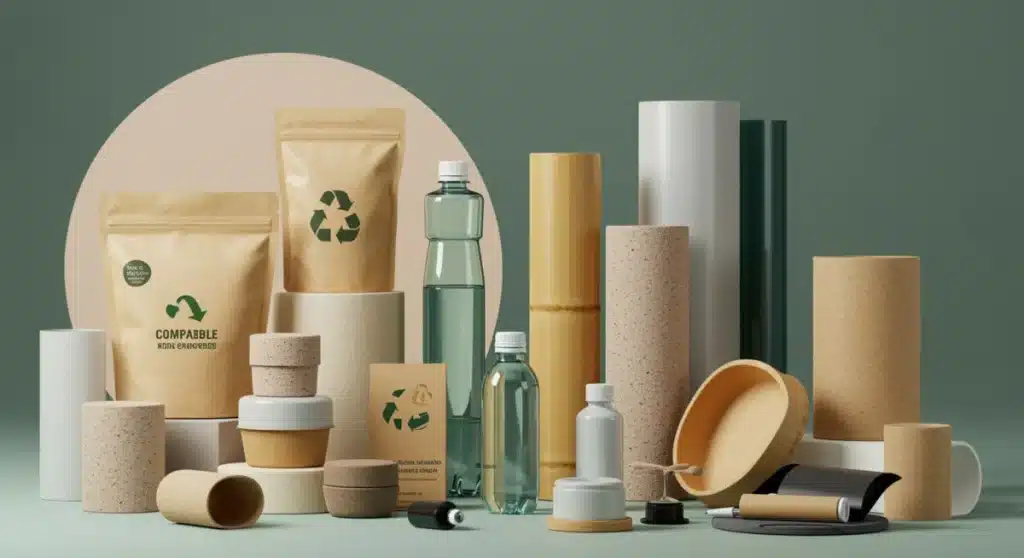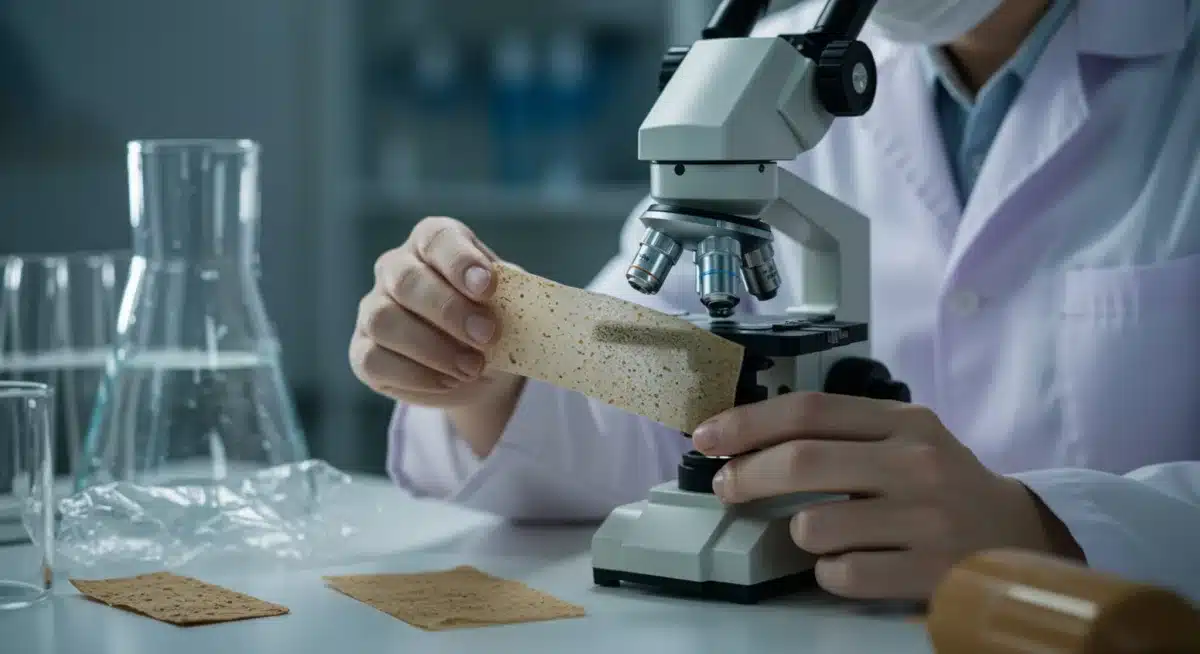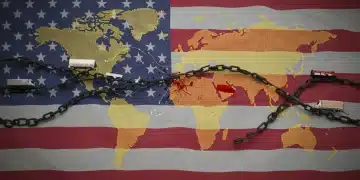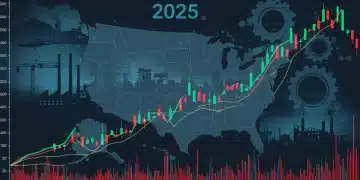Sustainable Packaging Innovation: Reducing US Waste

Sustainable packaging innovation in the US is rapidly evolving, offering crucial solutions to significantly reduce waste and mitigate environmental impact across diverse industries and consumer goods.
The imperative for sustainable packaging innovation
The urgency for sustainable packaging innovation has never been more pronounced in the United States. As consumer awareness grows and environmental concerns escalate, industries are scrambling to adopt practices that minimize their ecological footprint. This isn’t merely a trend but a fundamental shift towards more responsible consumption and production.
Traditional packaging materials, primarily plastics derived from fossil fuels, contribute significantly to landfill waste, ocean pollution, and greenhouse gas emissions. The long decomposition times of these materials pose a severe threat to ecosystems, urging a collective re-evaluation of how goods are packaged and distributed. The move towards sustainable alternatives is not just about compliance with regulations; it’s about securing a healthier planet for future generations while also meeting evolving consumer demands for eco-friendly products.
Furthermore, businesses are recognizing the economic benefits of sustainability. Reduced material costs, enhanced brand image, and access to new markets driven by environmentally conscious consumers are powerful motivators. This section will delve into the driving forces behind this critical shift and the overarching goals of sustainable packaging initiatives in the US.
Understanding the environmental impact of traditional packaging
Conventional packaging, especially single-use plastics, presents a formidable challenge to environmental health. Its pervasive presence in landfills and natural environments underscores the need for transformative change. The lifecycle of these materials often begins with resource extraction, a process that can be energy-intensive and ecologically damaging.
- Resource Depletion: Reliance on virgin materials, particularly petroleum for plastics, depletes finite natural resources.
- Pollution: Manufacturing processes release pollutants into the air and water, impacting local communities and ecosystems.
- Waste Accumulation: A significant portion of packaging ends up in landfills or as litter, taking hundreds of years to decompose.
- Oceanic Impact: Plastic debris in oceans harms marine life, entering the food chain and posing risks to human health.
These impacts extend beyond immediate visible pollution, contributing to climate change through greenhouse gas emissions at every stage, from production to disposal. Addressing these issues requires a holistic approach, focusing on innovation that not only replaces problematic materials but also rethinks the entire packaging ecosystem.
Consumer demand and regulatory pressures
The landscape of packaging is also being reshaped by a potent combination of consumer preferences and governmental regulations. Consumers, particularly younger demographics, are increasingly vocal about their desire for sustainable products and packaging.
This growing demand is pushing brands to innovate and communicate their sustainability efforts transparently. Companies that fail to adapt risk losing market share to more eco-conscious competitors. Simultaneously, legislative bodies at both federal and state levels are introducing policies aimed at reducing packaging waste.
- Extended Producer Responsibility (EPR) Schemes: These policies hold manufacturers accountable for the entire lifecycle of their products and packaging.
- Plastic Bans: Many states and cities have enacted bans on single-use plastic bags, straws, and other items.
- Recycling Targets: Governments are setting ambitious targets for recycling rates, incentivizing better collection and processing infrastructure.
These regulatory frameworks provide both challenges and opportunities, compelling businesses to invest in sustainable packaging solutions and fostering a more circular economy.
Emerging materials and technologies in sustainable packaging
The forefront of sustainable packaging innovation in the US is characterized by a vibrant landscape of new materials and advanced technologies. Researchers and companies are continuously exploring alternatives that offer comparable performance to traditional options while significantly reducing environmental impact. This pursuit involves not only discovering new compounds but also optimizing existing ones for greater sustainability.
A key focus is on materials that are renewable, biodegradable, compostable, or highly recyclable. The goal is to move away from linear ‘take-make-dispose’ models towards circular systems where materials are kept in use for as long as possible. This shift requires a deep understanding of material science and a commitment to continuous improvement.
From plant-based plastics to fungi-derived composites, the diversity of solutions being developed is impressive. These innovations are not just about replacing plastic; they are about reimagining the very concept of packaging to be inherently sustainable from its inception to its end-of-life.
Biodegradable and compostable materials
One of the most promising avenues in sustainable packaging is the development of biodegradable and compostable materials. Unlike traditional plastics that persist for centuries, these materials are designed to break down naturally in specific environments, returning to the earth without leaving harmful residues.
Biodegradable materials decompose through biological processes, while compostable materials break down into natural elements in a composting environment, often within a specific timeframe. The distinction is crucial for proper disposal and environmental benefit.
- Polylactic Acid (PLA): Derived from renewable resources like corn starch or sugarcane, PLA is a popular bioplastic used for various applications, including food containers and films.
- PHA (Polyhydroxyalkanoates): Produced by microorganisms, PHA plastics are fully biodegradable in marine and soil environments, making them ideal for challenging applications.
- Mushroom Packaging: Mycelium, the root structure of mushrooms, can be grown into custom shapes to create protective packaging that is fully compostable.
- Seaweed-based Packaging: Innovative companies are developing packaging from seaweed, offering a rapidly renewable and edible alternative to plastic.
While these materials hold immense potential, challenges remain in scaling production, ensuring proper composting infrastructure, and educating consumers on correct disposal methods.
Recycled content and closed-loop systems
Maximizing the use of recycled content and establishing closed-loop systems are critical components of sustainable packaging. This approach reduces the demand for virgin materials, conserves energy, and minimizes waste generation. Closed-loop systems aim to collect, process, and reuse packaging materials indefinitely.
The US is seeing significant investment in improving recycling infrastructure and developing technologies that can effectively sort and reprocess a wider range of materials. This includes advanced mechanical recycling, which reprocesses plastics into new products, and chemical recycling, which breaks down plastics into their molecular components for reuse.
Brands are increasingly committing to using a higher percentage of post-consumer recycled (PCR) content in their packaging, driven by both regulatory pressures and consumer preference. This not only reduces waste but also supports the circular economy by creating a market for recycled materials.

The success of closed-loop systems relies heavily on effective collection, sorting, and reprocessing technologies, as well as consumer participation in recycling programs. Continuous innovation in these areas is essential for achieving true material circularity.
The role of design in reducing packaging waste
Sustainable packaging innovation extends far beyond material selection; it deeply integrates with thoughtful design principles. Packaging design plays a pivotal role in minimizing waste, optimizing resource use, and enhancing the overall sustainability of a product. A well-designed package can reduce material usage, improve recyclability, and even extend product shelf life, all contributing to a lower environmental footprint.
This holistic approach considers the entire lifecycle of the package, from raw material sourcing to end-of-life disposal. Designers are increasingly challenged to think creatively about how to deliver products safely and efficiently while adhering to stringent sustainability criteria. This often means simplifying designs, eliminating unnecessary components, and choosing materials that are inherently easier to recycle or compost.
Ultimately, smart design is a powerful lever for achieving significant reductions in packaging waste and promoting a more sustainable consumption model. It’s about making conscious choices at every stage of the design process.
Minimalist packaging and material reduction
One of the most straightforward yet impactful strategies in sustainable packaging design is minimalism. By reducing the amount of material used in packaging, companies can significantly lower their environmental impact. This approach focuses on efficiency, stripping away excess layers and unnecessary components.
Minimalist design is not just about aesthetics; it’s about functionality and resource optimization. It challenges designers to achieve the same protective and informative functions with less material, often leading to innovative structural solutions.
- Right-sizing: Designing packaging that perfectly fits the product, eliminating empty space and the need for excessive void fill.
- Lightweighting: Using thinner materials or structural designs that reduce the overall weight of the package, saving on material and transportation costs.
- Eliminating Secondary Packaging: Where possible, removing outer boxes or wraps that are not essential for product protection or information.
These efforts not only conserve resources but also reduce transportation emissions due to lighter loads and more efficient packing. Minimalist packaging often resonates well with consumers who appreciate simplicity and transparency.
Designing for recyclability and reuse
Designing packaging with its end-of-life in mind is crucial for sustainability. Packaging that is easily recyclable or reusable contributes directly to a circular economy, keeping valuable materials out of landfills. This requires careful consideration of material choices, structural design, and labeling.
For recyclability, designers must ensure that different materials can be easily separated or that the package is made from a single, widely recyclable material. Contamination from labels, inks, or adhesives can hinder the recycling process, making these elements critical design considerations.
Reuse is another powerful strategy, particularly for durable goods or refillable systems. Designing for reuse involves creating robust packaging that can withstand multiple cycles of washing, refilling, and transportation. This often requires a significant shift in business models and consumer behavior.
- Mono-material design: Creating packaging from a single type of plastic or paper to simplify the recycling process.
- Removable labels: Designing labels that can be easily detached from the package to avoid contamination in recycling streams.
- Refillable containers: Developing durable packaging that consumers can refill, reducing the need for new packaging with every purchase.
These design principles are essential for ensuring that packaging materials can be effectively recovered and repurposed, minimizing their environmental impact throughout their lifespan.
Supply chain optimization for sustainability
Achieving sustainable packaging innovation in the US requires a comprehensive approach that extends beyond material science and design to encompass the entire supply chain. Optimizing supply chain processes for sustainability involves making conscious choices at every stage, from sourcing raw materials to product delivery. This holistic perspective ensures that environmental considerations are integrated into logistics, manufacturing, and distribution, leading to significant reductions in waste and emissions.
A sustainable supply chain not only minimizes environmental impact but also often results in operational efficiencies and cost savings. It demands collaboration among all stakeholders, including suppliers, manufacturers, retailers, and consumers, to create a truly circular and responsible system. The focus is on transparency, efficiency, and continuous improvement across the entire value chain.
By scrutinizing each step, companies can identify opportunities for improvement, such as reducing transportation distances, optimizing inventory, and implementing greener manufacturing processes. This integrated approach is vital for the widespread adoption and success of sustainable packaging initiatives.
Local sourcing and reduced transportation emissions
One effective strategy for supply chain optimization is to prioritize local sourcing of packaging materials. By procuring materials closer to manufacturing facilities, companies can significantly reduce the distance goods travel, thereby lowering transportation-related greenhouse gas emissions. This approach also supports local economies and can improve supply chain resilience.
Reducing transportation emissions is a critical component of overall environmental sustainability. Long-haul shipping, especially by air or truck, consumes substantial amounts of fossil fuels and contributes to air pollution. Shifting to more localized supply networks can alleviate these pressures.
- Regional Material Hubs: Developing regional centers for sourcing and processing sustainable packaging materials.
- Consolidated Shipments: Optimizing logistics to combine multiple shipments, reducing the number of trips and fuel consumption.
- Efficient Route Planning: Utilizing advanced software to plan the most fuel-efficient delivery routes.
While global supply chains offer certain advantages, a strategic re-evaluation of sourcing locations can yield substantial environmental benefits, particularly for high-volume packaging components.
Waste reduction in manufacturing and logistics
Minimizing waste throughout the manufacturing and logistics stages of the packaging supply chain is another crucial area for sustainable innovation. This involves implementing lean manufacturing principles, optimizing production processes, and reducing packaging damage during transit.
In manufacturing, efforts focus on reducing scrap rates, reusing production waste, and optimizing energy consumption. Advanced technologies like automation and predictive analytics can play a significant role in improving efficiency and reducing waste generation.
For logistics, robust packaging design and efficient handling procedures are essential to prevent product damage, which often leads to packaging waste and additional transportation for replacements. Innovations in protective packaging, such as reusable crates or optimized void fill, can minimize these issues.
- Zero-Waste Manufacturing: Implementing processes designed to eliminate or drastically reduce waste generation during production.
- Returnable Packaging Systems: Using durable, reusable containers for shipping components between facilities.
- Smart Inventory Management: Reducing overproduction and spoilage through accurate demand forecasting.
These efforts collectively contribute to a more efficient and environmentally responsible supply chain, reinforcing the broader goals of sustainable packaging.
Industry adoption and successful case studies
The journey towards widespread sustainable packaging innovation in the US is marked by significant progress and inspiring success stories across various industries. From global corporations to agile startups, an increasing number of entities are not only embracing sustainable practices but also demonstrating tangible results. These case studies serve as powerful examples, illustrating that environmental responsibility can go hand-in-hand with business viability and even competitive advantage.
The adoption of sustainable packaging is driven by a combination of factors: consumer demand, regulatory pressures, and a genuine commitment to corporate social responsibility. Companies are investing in research and development, re-evaluating their supply chains, and collaborating with innovators to bring new solutions to market. This section will highlight some notable examples of how different sectors are successfully integrating sustainable packaging into their operations, providing valuable insights and demonstrating the potential for broader impact.
These examples not only validate the feasibility of sustainable packaging but also inspire further innovation and adoption across the industrial landscape.
Food and beverage sector leadership
The food and beverage industry, a major user of packaging, has been at the forefront of sustainable packaging innovation. Driven by high consumer visibility and the need for robust, safe packaging, many companies are making significant strides. Innovations range from plant-based bottles to compostable food wraps and refillable systems.
Leading brands are experimenting with new materials, optimizing their existing packaging, and investing in circular economy initiatives. The sheer volume of packaging used in this sector means that even small changes can have a massive positive impact on the environment.
- Coca-Cola: Investing in PlantBottle technology, which replaces some petroleum-based materials with plant-based ones, and increasing the use of recycled PET.
- Starbucks: Piloting reusable cup programs and developing a fully compostable paper cup.
- Nestlé: Committed to making 100% of its packaging recyclable or reusable by 2025, exploring alternative materials like paper-based packaging for various products.
These companies are not only reducing their environmental footprint but also enhancing their brand image and meeting the demands of eco-conscious consumers.
Consumer goods and e-commerce advancements
The consumer goods and e-commerce sectors face unique packaging challenges, particularly with the rise of direct-to-consumer shipping. Over-packaging and the use of non-recyclable materials have been common issues. However, innovation in these areas is rapidly addressing these concerns.
Companies are focusing on right-sizing packages, using recycled and recyclable materials for shipping, and exploring reusable delivery systems. The goal is to deliver products safely while minimizing waste and reducing the overall environmental impact of online shopping.

- Amazon: Implementing “Frustration-Free Packaging” to reduce waste, using smaller, easier-to-open, and recyclable packaging.
- Lush Cosmetics: Known for its “naked” packaging philosophy, offering many products without any packaging or in reusable/recyclable containers.
- P&G: Developing refillable packaging systems for brands like Head & Shoulders and Pantene, aiming to reduce plastic use.
These efforts demonstrate a commitment to sustainability in sectors where packaging plays a crucial role in product delivery and consumer experience.
Challenges and future outlook for sustainable packaging
While significant strides have been made in sustainable packaging innovation in the US, the path forward is not without its challenges. The transition from conventional to sustainable practices involves complex considerations, ranging from material performance and cost to infrastructure development and consumer behavior. Addressing these hurdles effectively will be crucial for accelerating the adoption of eco-friendly packaging solutions and realizing their full environmental benefits.
The future of sustainable packaging is bright with potential, but it requires continuous innovation, collaborative efforts, and supportive policies. Overcoming existing barriers will unlock new opportunities for businesses, foster a more circular economy, and contribute significantly to global climate goals. This section will explore the primary challenges that sustainable packaging faces and outline the promising outlook for its continued evolution and widespread implementation.
Understanding these dynamics is essential for anyone invested in the future of environmental sustainability and responsible commerce.
Cost and performance trade-offs
One of the persistent challenges in sustainable packaging is balancing cost-effectiveness with performance. Often, new sustainable materials or technologies can be more expensive than their traditional counterparts, posing a barrier to widespread adoption, especially for smaller businesses.
Furthermore, sustainable materials must meet the same rigorous performance standards as conventional packaging, including protection, shelf life, and durability. Ensuring that eco-friendly alternatives can withstand the rigors of manufacturing, shipping, and retail environments without compromising product integrity is a critical consideration.
- Material Costs: The initial investment in developing and producing novel sustainable materials can be higher.
- Scalability: Scaling up production of new materials to meet demand can be challenging and costly.
- Performance Gaps: Some sustainable materials may not yet match the barrier properties or strength of traditional plastics, requiring ongoing research and development.
Innovations aimed at reducing production costs and enhancing material performance are essential to overcome these trade-offs and make sustainable packaging more accessible and competitive.
Infrastructure and consumer education gaps
Even with innovative sustainable packaging solutions, their environmental benefits can only be fully realized if appropriate infrastructure for collection, sorting, and reprocessing exists. In the US, recycling and composting infrastructure varies significantly by region, creating confusion for consumers and hindering the effectiveness of sustainable packaging efforts.
Consumer education is equally vital. Many consumers are unaware of how to properly dispose of new sustainable packaging materials, leading to contamination in recycling streams or misdirection to landfills. Clear labeling and educational campaigns are necessary to guide consumers towards correct disposal practices.
- Inconsistent Recycling Facilities: Lack of standardized recycling and composting systems across different municipalities.
- Consumer Confusion: Difficulty for consumers to identify which materials are recyclable or compostable and how to dispose of them correctly.
- Lack of Processing Capacity: Insufficient facilities to process certain types of sustainable materials, such as specific bioplastics.
Addressing these infrastructure and education gaps requires coordinated efforts from governments, businesses, and communities to build a truly circular economy for packaging.
Policy and collaboration driving sustainable change
The acceleration of sustainable packaging innovation in the US is significantly influenced by supportive government policies and robust industry collaborations. While individual company efforts are crucial, systemic change often necessitates regulatory frameworks that incentivize sustainable practices and foster a level playing field. Furthermore, partnerships between businesses, research institutions, and non-profits are catalyzing the development and adoption of cutting-edge solutions, pushing the boundaries of what’s possible in eco-friendly packaging.
These synergistic forces create an environment where innovation can thrive, ensuring that sustainable packaging is not just a niche market but a mainstream reality. Policies can establish clear guidelines, set ambitious targets, and provide financial incentives, while collaborations leverage diverse expertise and resources to overcome complex challenges. This section will explore how effective policy-making and strategic partnerships are foundational to building a more sustainable future for packaging in the US.
Together, these elements form a powerful engine for driving transformative change across the entire packaging ecosystem.
Government initiatives and legislation
Government bodies at federal, state, and local levels are increasingly enacting policies designed to promote sustainable packaging and reduce waste. These initiatives often aim to create a more circular economy by encouraging recycling, discouraging single-use plastics, and holding producers accountable for their packaging’s lifecycle.
Legislation can provide the necessary impetus for industries to invest in sustainable solutions, ensuring that environmental considerations are integrated into business practices rather than being optional add-ons. Such policies often include clear targets and timelines, driving continuous improvement.
- Extended Producer Responsibility (EPR) Laws: Mandating that producers finance the collection and recycling of their packaging, shifting the burden from taxpayers.
- Plastic Bag Bans and Fees: Local and state regulations aimed at reducing the consumption of single-use plastic bags.
- Recycled Content Mandates: Requiring new packaging to include a certain percentage of post-consumer recycled materials.
These legislative efforts are critical for creating a consistent framework that supports the broader adoption of sustainable packaging practices across the nation.
Industry partnerships and research collaborations
Collaboration is a cornerstone of sustainable packaging innovation. No single entity can solve the complex challenges of waste reduction and environmental impact alone. Industry partnerships, cross-sector alliances, and academic research collaborations are vital for sharing knowledge, pooling resources, and accelerating the development of new materials and technologies.
These collaborations often bring together diverse expertise, from material scientists and packaging engineers to logistics experts and consumer behavior specialists. By working together, stakeholders can identify common challenges, develop industry-wide standards, and scale up promising solutions more effectively.
- The Recycling Partnership: A non-profit that collaborates with cities, companies, and communities to improve recycling systems.
- Sustainable Packaging Coalition (SPC): A membership-based collaborative that provides a platform for companies to share best practices and develop sustainable packaging solutions.
- Academic-Industry Research Programs: Universities partnering with corporations to conduct cutting-edge research on new biodegradable materials and recycling technologies.
These partnerships are instrumental in fostering innovation, streamlining the adoption of sustainable practices, and creating a collective impact that far exceeds what individual efforts could achieve.
| Key Aspect | Brief Description |
|---|---|
| Material Innovation | Development of biodegradable, compostable, and plant-based alternatives to traditional plastics. |
| Design for Circularity | Focus on minimalist design, recyclability, and reusability to reduce waste and resource consumption. |
| Supply Chain Optimization | Strategies like local sourcing and efficient logistics to lower emissions and manufacturing waste. |
| Policy & Collaboration | Government regulations and industry partnerships driving systemic change and innovation adoption. |
Frequently Asked Questions about Sustainable Packaging
Sustainable packaging innovation involves developing and implementing packaging solutions that minimize environmental impact throughout their lifecycle. This includes using renewable or recycled materials, designing for recyclability or compostability, and optimizing supply chains to reduce waste and emissions.
It’s crucial for reducing the vast amount of waste sent to landfills and oceans, mitigating pollution, and lowering carbon footprints. It also addresses growing consumer demand for eco-friendly products and helps companies comply with evolving environmental regulations.
Key materials include biodegradable bioplastics like PLA and PHA, compostable mushroom-based packaging, seaweed-derived films, and packaging made from high percentages of post-consumer recycled (PCR) content. Paper and cardboard from sustainably managed forests are also vital.
Design is fundamental. It focuses on minimalism to reduce material use, right-sizing to eliminate excess, and creating packaging that is easily recyclable or reusable. Designing for mono-materials and easily removable labels also enhances recyclability.
Challenges include the higher cost of some sustainable materials, ensuring performance matches traditional alternatives, inconsistent recycling and composting infrastructure across regions, and the need for greater consumer education on proper disposal.
Conclusion
The landscape of sustainable packaging innovation in the US is dynamic and rapidly evolving, driven by a confluence of environmental urgency, consumer demand, and forward-thinking policies. From groundbreaking material science to intelligent design and optimized supply chains, the collective effort to reduce waste and environmental impact is gaining significant momentum. While challenges persist in terms of cost, performance, and infrastructure, the ongoing commitment from industries, governments, and consumers alike paints a promising picture for a future where packaging is no longer a burden on the planet but an integral part of a circular, sustainable economy. Continued collaboration and innovation will be key to unlocking the full potential of these transformative solutions, ensuring a healthier environment for generations to come.





